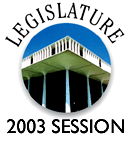
Older Oahu residential high-rises, 75 feet or higher, would be required to install sprinklers under a city bill that has sparked a renewed debate on cost vs. safety. Bill to require sprinklers
in old high-rises debatedResidential buildings over 75 feet
would have to install themBy Crystal Kua
ckua@starbulletin.com"We don't want to do anything that's going to create a tremendous amount of financial hardship, but we also have to make sure that we ensure public safety," said Donovan Dela Cruz, chairman of the City Council Public Safety Committee, who introduced the bill.
"You cannot put a price on people's lives."
Dela Cruz is also drafting a resolution that calls for a task force to hash out ways to balance public safety with concerns over the cost of retrofitting.
Legislature Directory
Legislature Bills & Hawaii Revised Statutes
"I'm hoping that this eventual task force will come up with ways so we can achieve both -- so we can make it financially reasonable or feasible and ... so that the Fire Department will be satisfied and so will the apartment owners, renters and occupants," Dela Cruz said.
An ordinance passed in 1975 required that all new high-rises have sprinklers, but the measure exempted existing buildings.
Following the 1980 Las Vegas MGM Grand Hotel fire, the City Council mandated that older hotels install sprinkler systems, but 35 commercial and 300 residential high-rises were not included.
Three years ago yesterday, Hawaii's worst high-rise fire occurred at the Interstate Building on King Street in Pawaa. The fire destroyed the top floor of the building and injured 11 firefighters. Sprinklers, which were not required, would have helped firefighting efforts, firefighters said at the time.
In 2001 the Council approved a bill that required sprinkler systems in commercial high-rises built before 1975 and which gave owners five years to complete the retrofitting.
High-rise fires present particular firefighting challenges, said Lloyd Rogers, battalion chief of the Honolulu Fire Department Fire Prevention Bureau.
"You have water issues where you have to pump water into buildings, get firefighters up to where the fire is, you have a lot of smoke and heat in an enclosed area -- corridors and rooms -- a whole series of complications," Rogers said. "It's not only life issues for residents, but for the firefighters, too."
Jane Sugimura, president of the Hawaii Council of Associations of Apartment owners, said the obstacle continues to be cost of installing the sprinklers.
"It is cost mainly because it is very expensive," said Sugimura, who said estimates about three years ago came in at around $8,000 per unit.
"We're not against health and safety ... but the thing of it is, they just can't pass a bill and expect everybody to do it."
She said that residential high-rises have safety features including concrete walls to contain a blaze and 24-hour occupancy and security.
A task force convened after the Interstate fire looked at including residential high-rises in the sprinkler bill for commercial buildings but dropped the issue due mainly to opposition by apartment owners.
While the bill currently mandates that retrofitting would have to be done five years after the bill is passed, Dela Cruz said that the retrofitting could be phased in over a longer period of time.
"We need to plan to accomplish this even it it's over a 10-year period," he said.
